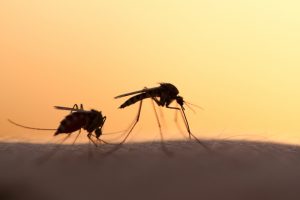DISEASES FROM TICKS AND MOSQUITOES SURGE
By Chris Williams on May 28, 2018.
We pretty much knew it was happening and we had theories as to why. Now we have official government confirmation that diseases spread by ticks and mosquitoes have been increasing rapidly in the U.S. in the last several years.
The Centers for Disease Control has just issued a new finding that illnesses from mosquito and tick bites more than tripled in the 12 years from 2004 to 2016. While this is impressive, officials say that the actual number of people that got sick is much higher because so many cases go undiagnosed or unreported. For example, current data suggests that Lyme disease infects about 300,000 Americans every year but annual cases reported to CDC number only about 37,000.
TEMPERATURE INCREASES FAVOR DISEASE TRANSMISSION
One reason for the recent increase in these mosquito and tick-transmitted diseases is that climate changes have allowed these vectors to become active earlier in spring and stay active later into fall, and to survive winters when previously it was too cold. Lyle Petersen, director of the CDC’s Division of Vector-Borne Diseases and author of the report says, “For ticks, the higher temperatures have allowed them to spread into new areas, allowing them to live farther north, and that puts more people at risk…What’s more, when the tick season is longer, people are exposed over longer periods.”
IT’S MORE THAN JUST THE WEATHER
According to CDC, we can’t blame all of the increase in disease incidence on the weather. Other reported factors are:
- Increases in international travel, especially to tropical regions, transfer mosquito vectors, as well as infected people, into new areas.
- An increase in deer populations almost everywhere has contributed to Lyme disease numbers since ticks feeding on deer are part of the disease’s transmission cycle.
- For many of the mosquito and tick diseases, smaller animals such as mice and birds are intermediary hosts that help maintain the disease. Larger predators that used to keep these smaller animals in check have disappeared. Small infected animals are difficult to find and probably impossible to treat or eliminate.
- New vector-transmitted pathogens seem to be appearing at a faster rate. During the years of the CDC study (2004-2016), nine brand new disease organisms that are spread by bites from infected mosquitoes and ticks were discovered or introduced into the U.S. A lack of vaccines for these new diseases adds to the increase.
- It’s usually local and state health departments and mosquito control organizations that bear the primary responsibility for responding to disease outbreaks. Funding for these agencies has not been keeping up with the increased need.
Perhaps the recent mosquito Zika virus outbreak in Puerto Rico and parts of Florida and Texas was useful in some ways because it forced other state and local authorities to evaluate and improve their capacities to fight these pests and potential outbreaks. According to Petersen, “This is a long-term problem that’s going to get worse, and it requires a sustained response over time.”
